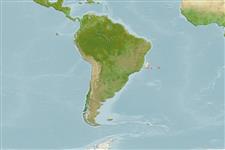>
Eupercaria/misc (Various families in series Eupercaria) >
Scaridae (Parrotfishes) > Sparisomatinae
Etymology: Sparisoma: Latin, sparus = a fish with a golden head + Greek, soma = body (Ref. 45335); rocha: Named for Luiz A. Rocha and additionally 'rocha' means rock in Portuguese, alluding to the volcanic rocky formation of Trindade Island (its type locality); noun in apposition..
Environment: milieu / climate zone / depth range / distribution range
Ecologie
marien rifbewoner; diepte 10 - 25 m (Ref. 84274). Tropical
Southwestern Atlantic: off Brazil, Trindade Island.
Grootte / Gewicht / Leeftijd
Maturity: Lm ? range ? - ? cm
Max length : 30.5 cm SL mannelijk / geslacht onbekend; (Ref. 114982)
Korte beschrijving
Determinatiesleutels | Morfologie | Morfometrie
Dorsale stekels (totaal) : 9; Dorsale zachte stralen (totaal) : 10; Anale stekels: 3; Anale zachte stralen: 9. This species is distinguished from its Southwestern Atlantic congeners by the following unique colour characters: initial phase (IP) is red overall with a brownish shade from lower jaw to over the abdominal cavity, sparse orange blotches on head, and a pale circumpeduncular band. The terminal phase (TP) on the other hand is reddish brown with orange stripe from jaw angle to end of preopercle, sparse orange blotches on head, with 3 pinkish to reddish stripes from about midline to dorsum, from midline to belly pale greyish green to whitish with suffusion of pale reddish brown, a black spot on base of pectoral fins and a bright-yellow blotch below this spot. Furthermore, mitochondrial 12S and 16S rRNA loci sequences do not match any known Sparisoma species (Ref. 84274).
This species is a scraper and has been recorded to graze upon epilithic algae growing on rocky and calcareous substrata at 10-25 m depth. The males are solitary, whereas the females may be seen alone or in couples and accompanied by juveniles. These juveniles are small, about 2-5 cm, and associate with mixed groups of the labrids Halichoeres penrosei and Thalassoma noronhanum, which have a similar colour pattern. This association may be considered as a form of social mimicry (Ref. 84274).
Levenscyclus en paargedrag
Maturities | Voortplanting | Spawnings | Egg(s) | Fecundities | Larven
Pinheiro, H.T., J.L. Gasparini and I. Sazima, 2010. Sparisoma rocha, a new species of parrotfish (Actinopterygii: Labridae) from Trindade Island, South-western Atlantic. Zootaxa 2493:59-65. (Ref. 84274)
Status op de Rode Lijst van het IUCN (Ref. 130435)
Gevaar voor de mens
Harmless
Gebruik door de mens
Tools
Speciale rapporten
Download XML
Internetbronnen
Estimates based on models
Preferred temperature (Ref.
123201): 25.5 - 27.4, mean 25.8 °C (based on 4 cells).
Fylogenetische diversiteitsindex (Ref.
82804): PD
50 = 0.5000 [Uniqueness, from 0.5 = low to 2.0 = high].
Bayesian length-weight: a=0.01122 (0.00665 - 0.01894), b=3.10 (2.95 - 3.25), in cm total length, based on LWR estimates for this species & Genus-body shape (Ref.
93245).
Trofisch niveau (Ref.
69278): 2.0 ±0.1 se; based on size and trophs of closest relatives
Weerstandsvermogen (Ref.
120179): Gemiddeld, minimale populatieverdubbelingstijd 1,4-4,4 jaar (Preliminary K or Fecundity.).
Fishing Vulnerability (Ref.
59153): Low to moderate vulnerability (27 of 100).
